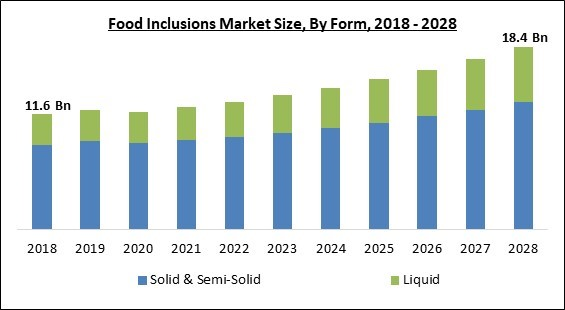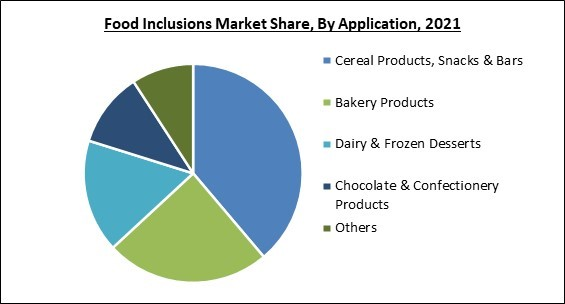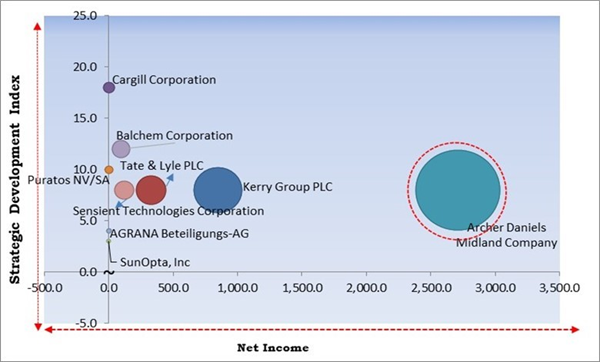The Global Food Inclusions Market size is expected to reach $18.4 billion by 2028, rising at a market growth of 6.1% CAGR during the forecast period.
Food inclusions that contribute to a product's health benefits are gaining popularity. Additionally, food inclusions have a wide range of uses, including in bakery goods, breakfast cereals, dairy and frozen desserts, as well as chocolate and confectionery products. Food inclusions are substances that are added to food to improve its sensory, aesthetically pleasing, and organoleptic qualities.
Dry fruits, nuts, chocolates, fruit chunks, herbs, and spices are a few commonly used food inclusions. The ability of food inclusions to add flavor, color, aroma, and textural components to food products is attracting the consumers as well as manufacturers. The food inclusion market will be driven by consumers' growing preference for food products with added value, such as frosting with edible glitter and cake batter with candy confetti.
Customer interest in plant-based foods and healthy snacks is growing, which is driving demand for food products that contain nuts, seeds, and particular herbs. Consumers appear to be more open to try new things when they are added with a twist, such as melon seeds as well as lotus seeds in smoothie bowls, according to the food industry. To give the food products a variety of tastes, food inclusions come in a variety of flavors, including savory, chocolate, caramel, fruit flavors, and caramel.
The major strategies followed by the market participants are Acquisitions. Based on the Analysis presented in the Cardinal matrix; Archer Daniels Midland Company is the forerunners in the Food Inclusions Market. Companies such as Balchem Corporation, Tate & Lyle PLC, Ltd., Cargill Corporation are some of the key innovators in Food Inclusions Market.
The market research report covers the analysis of key stake holders of the market. Key companies profiled in the report include Kerry Group PLC, Cargill Corporation, Archer Daniels Midland Company, Tate & Lyle PLC, AGRANA Beteiligungs-AG, Puratos NV/SA, Balchem Corporation, Sensient Technologies Corporation, SunOpta, Inc, Chaucer Foods Ltd. (Pilgrim Food Group PLC), and Apple, Inc.
Food inclusions that contribute to a product's health benefits are gaining popularity. Additionally, food inclusions have a wide range of uses, including in bakery goods, breakfast cereals, dairy and frozen desserts, as well as chocolate and confectionery products. Food inclusions are substances that are added to food to improve its sensory, aesthetically pleasing, and organoleptic qualities.
Dry fruits, nuts, chocolates, fruit chunks, herbs, and spices are a few commonly used food inclusions. The ability of food inclusions to add flavor, color, aroma, and textural components to food products is attracting the consumers as well as manufacturers. The food inclusion market will be driven by consumers' growing preference for food products with added value, such as frosting with edible glitter and cake batter with candy confetti.
Customer interest in plant-based foods and healthy snacks is growing, which is driving demand for food products that contain nuts, seeds, and particular herbs. Consumers appear to be more open to try new things when they are added with a twist, such as melon seeds as well as lotus seeds in smoothie bowls, according to the food industry. To give the food products a variety of tastes, food inclusions come in a variety of flavors, including savory, chocolate, caramel, fruit flavors, and caramel.
COVID-19 Impact Analysis
The consumer's desire for new & innovative products to engage in different culinary adventures is also influencing market trends for food inclusions in an effort to break free from the monotonous routine imposed by the lockdown. Growing demand for fruits and nuts is anticipated in the coming years due to their potential for improving health. Since people are unable to travel & experience the exotic flavors of various regions & countries, travel restrictions are having an impact on flavor trends in food products and beverages. Therefore, despite having a negative effect on the production & supply of food inclusions, the COVID-19 pandemic has had a positive impact on market product trends.Market Growth Factors
Evolving Flavor Profiles And Consumer Preferences
The food and beverage industry is undergoing a number of innovations as consumer taste preferences shift. The food and beverage manufacturers are creating products with distinctive flavors because consumers are eager to try new and appealing products with flavor variety and other attributes. For instance, chocolate producers typically use fruits like strawberries, raspberries, and cherries, but they are now also incorporating peaches into their products. Similar to how hazelnuts, almonds, and peanuts are three of the most widely consumed nuts, chocolate producers are now also incorporating pistachio, flax, and sunflower seeds into their confections.Consumers' Growing Preference For Value-Added Food
The demand for goods like food inclusions has accelerated as a result of the increased demand for processed foods with some kind of value addition. The market for food inclusions is being driven by a variety of factors, including changes in dietary habits, shifting consumer food consumption patterns, and rising consumer demand for and acceptance of creative recipes. The demand for food inclusions has increased as a result of factors like changing lifestyles, rising disposable income, and growing adoption of convenience snacks & confections.Market Restraining Factors
The Consequent Rise In The Cost Of Finished Goods
Food inclusions are typically used in a variety of applications, such as bakery goods, cereal goods, snacks, and bars to enhance the flavor and nutritional value of the products; as a result, they are generally more expensive and directly affect the final cost of the finished goods. The high cost of inclusions' raw materials and their evolving use in food and beverage products are the main causes of their high price. Additionally, there is a need for distinctive products because consumer taste preferences are evolving.Type Outlook
Based on type, the food inclusions market is segmented into chocolate, fruit & nut, cereal, flavored sugar & caramel, confectionery and other types (biscuit & cookies, color & Bean and plant-based inclusions). The chocolate segment acquired a significant revenue share in the food inclusions market in 2021. One of the main food products that has enjoyed decades long popularity is chocolate, especially in the younger age groups. The majority of the products made with cocoa include dark chocolate, milk chocolate, white chocolate, semi-sweet or bittersweet chocolate, cocoa solids, cocoa powder, cocoa butter, and chocolate liquor.Application Outlook
On the basis of application, the food inclusions market is fragmented into cereal products, snacks & bars, bakery products, dairy & frozen desserts, chocolate & confectionery products and other applications products. The bakery products segment acquired a significant revenue share in the food inclusions market in 2021. Cookies, bagels, buns, pastries, sandwiches, muffins, cakes, biscuits, pizzas, brownies, and other baked goods are examples of bakery products. For the topping, flavoring, decoration, and other uses, food inclusions are frequently used in bakery products.Form Outlook
By form, the food inclusions market is divided into solid & semi-solid and liquid. The solid & semi-solid segment led the food inclusions market with the highest revenue share in 2021. Included in the category of solid food inclusions are bits, chips, nuts nibs, crunchies, and flakes. Customers are much attracted towards nuts in their solid form, and they are frequently found in baked goods, confections, dairy products, snacks and bars, frozen desserts, cereals, and beverages.Regional Outlook
Region wise, the food inclusions market is analyzed across North America, Europe, Asia Pacific and LAMEA. In 2021, the Europe region witnessed the highest revenue share in the food inclusions market. Due to its size, it continues to be a significant market for food inclusion companies. Leading nations in the European food inclusions market include France, Germany, and the U.K. Increased use of clean-level flavored and natural food products in diet foods has had an impact on the growth of the food inclusions market in this country as consumers in the region adopt healthier lifestyles.Cardinal Matrix-Food Inclusions Market Competition Analysis
The major strategies followed by the market participants are Acquisitions. Based on the Analysis presented in the Cardinal matrix; Archer Daniels Midland Company is the forerunners in the Food Inclusions Market. Companies such as Balchem Corporation, Tate & Lyle PLC, Ltd., Cargill Corporation are some of the key innovators in Food Inclusions Market.
The market research report covers the analysis of key stake holders of the market. Key companies profiled in the report include Kerry Group PLC, Cargill Corporation, Archer Daniels Midland Company, Tate & Lyle PLC, AGRANA Beteiligungs-AG, Puratos NV/SA, Balchem Corporation, Sensient Technologies Corporation, SunOpta, Inc, Chaucer Foods Ltd. (Pilgrim Food Group PLC), and Apple, Inc.
Strategies deployed in Food Inclusions Market
Partnerships, Collaborations and Agreements:
- Aug-2022: ADM came into a partnership with Benson Hill, a food tech company unlocking the natural genetic diversity of plants. This partnership aimed at scaling innovative soy ingredients that would help meet the rapidly increasing demand for plant-based proteins. The partnership would serve a variety of plant-based food & beverage markets to meet savory, sweet, and dairy consumer needs.
- Aug-2022: ADM partnered with New Culture, a pioneering animal-free dairy company. This partnership focused on accelerating the development & commercialization of alternative dairy products. The partnership would help meet fast-growing customer interest in alternative dairy & cheese.
- May-2021: Cargill partnered with Caldic, a chemical supply chain services company. Through this partnership, the companies focused on the consumer-centric approach to doing business & the development of innovative solutions that enable the companies to further expand within the Swiss food market.
Product Launches and Product Expansions:
- Aug-2020: SunOpta released arbor bar, a certified organic bar. Through this launch, SunOpta focused on new opportunities for growth in the multi-billion-dollar snack bar segment. This launch aimed at providing a bar that elevates & celebrates the simple goodness of fruit with 0 grams of added sugar & only five ingredients or fewer.
- Jan-2020: Puratos launched Smoobees, a new range of inclusions, which would offer a creamy texture and rich taste. Smoobees would allow food producers to address the challenges of adding inclusions to cakes without having to adapt their production processes.
Acquisitions and Mergers:
- Jun-2022: Balchem took over Kappa Bioscience, a leading science-based manufacturer of specialty vitamin K2. Through this acquisition, the company aimed at expanding its portfolio of science-based specialty nutrients with leading positions in growing markets.
- May-2022: Tate & Lyle took over Nutriati, an ingredient technology company. This acquisition aimed at complement the existing ingredient portfolio perfectly and would support the company's purpose pillars of supporting healthy living and caring for their planet. Also, the acquisition aimed at fully maximizing the strong functional benefits of these plant-based, chickpea-derived products & offering a broad range of fortification solutions to the consumers.
- Mar-2022: Tate & Lyle announced the acquisition of Quantum Hi-Tech (Guangdong) Biological, a prebiotic dietary fiber business. This acquisition would expand Tate & Lyle’s ability to provide added-fiber solutions for its consumers across a range of categories that includes dairy, beverages, bakery, and nutrition, and to meet increasing customer interest in gut health.
- Feb-2022: Kerry Group announced the acquisition of c-LEcta, a world-leading, technology-driven biotechnology company. This acquisition would accelerate Kerry’s innovation capabilities in fermentation, enzyme engineering, and bioprocess development. This acquisition would further support Kerry’s commitment to invest in the development of innovative sustainable technologies, which would be at the heart of future sustainable food & health systems.
- Feb-2022: Balchem completed the acquisition of Cardinal Associates. Under this acquisition, Balchem would launch OptiMSM, which would provide a synergistic scientific advantage in Balchem’s key strategic therapeutic focus areas like longevity & performance.
- Nov-2021: ADM signed an agreement to acquire Sojaprotein, a leading European provider of non-GMO soy ingredients. The acquisition aimed at a significant expansion of ADM’s global alternative protein capabilities and its ability to meet the rising demand for plant-based foods & beverages.
- Oct-2021: Sensient Technologies completed the acquisition of Flavor Solutions, a provider of flavors and flavor technologies to the food, beverage, and nutraceutical markets. The acquisition would enable Sensient to expand its flavor portfolio through the expansion of new flavor offerings, and the addition of savory reaction flavors.
- Aug-2021: Cargill signed an agreement to acquire Aalst Chocolate, a Singapore-based world-class chocolate manufacturer. The acquisition would allow Cargill to become the supplier-of-choice for industrial & food service consumers. The company aimed at accelerating innovation, better-helping consumers create products that continue to surprise and delight.
- Jul-2021: Kerry Group signed an agreement to acquire Biosearch Life, a leading biotechnology company. This acquisition aimed at expanding Kerry's portfolio of healthy ingredients, like probiotics & omega 3s. This would further boost the company's capabilities within functional foods and proactive health ingredients.
- May-2021: Cargill took over Leman Decoration Group, a leading supplier of cake decorations across the bakery sector. The acquisition would broaden Cargill's offerings in the decorations space, allowing the company's cocoa & chocolate business to better serve gourmet customers in Europe and across the globe.
- Mar-2021: Agrana acquired Taiyo Kagaku, the fruit preparations business of a local food producer. This acquisition aimed at the company's expansion in the Asia region.
Scope of the Study
Market Segments Covered in the Report:
By Application
- Cereal Products, Snacks & Bars
- Bakery Products
- Dairy & Frozen Desserts
- Chocolate & Confectionery Products
- Others
By Type
- Fruit & Nut
- Chocolate
- Cereal
- Flavored Sugar & Caramel
- Confectionery & Others
By Form
- Solid & Semi-Solid
- Pieces
- Nuts
- Flakes & Crunches
- Powder
- Chips & Nibs
- Liquid
By Geography
- North America
- US
- Canada
- Mexico
- Rest of North America
- Europe
- Germany
- UK
- France
- Russia
- Spain
- Italy
- Rest of Europe
- Asia Pacific
- China
- Japan
- India
- South Korea
- Singapore
- Malaysia
- Rest of Asia Pacific
- LAMEA
- Brazil
- Argentina
- UAE
- Saudi Arabia
- South Africa
- Nigeria
- Rest of LAMEA
Key Market Players
List of Companies Profiled in the Report:
- Kerry Group PLC
- Cargill Corporation
- Archer Daniels Midland Company
- Tate & Lyle PLC
- AGRANA Beteiligungs-AG
- Puratos NV/SA
- Balchem Corporation
- Sensient Technologies Corporation
- SunOpta, Inc
- Chaucer Foods Ltd. (Pilgrim Food Group PLC)
- Apple, Inc.
Unique Offerings from the Publisher
- Exhaustive coverage
- The highest number of Market tables and figures
- Subscription-based model available
- Guaranteed best price
- Assured post sales research support with 10% customization free
Table of Contents
Chapter 1. Market Scope & Methodology
Chapter 2. Market Overview
Chapter 3. Competition Analysis - Global
Chapter 4. Global Food Inclusions Market by Application
Chapter 5. Global Food Inclusions Market by Type
Chapter 6. Global Food Inclusions Market by Form
Chapter 7. Global Food Inclusions Market by Region
Chapter 8. Company Profiles
Companies Mentioned
- Kerry Group PLC
- Cargill Corporation
- Archer Daniels Midland Company
- Tate & Lyle PLC
- AGRANA Beteiligungs-AG
- Puratos NV/SA
- Balchem Corporation
- Sensient Technologies Corporation
- SunOpta, Inc
- Chaucer Foods Ltd. (Pilgrim Food Group PLC)
- Apple, Inc.
Methodology

LOADING...











